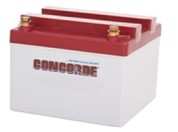Mon, Jul 26, 2010
Concorde Battery Discusses Parasitic Drain
 Concorde recently issued Technical Bulletin No. 10 "Parasitic
Drain", in response to questions throughout the aviation community
about the effect of parasitic drain on battery state of
charge. A parasitic drain is an electrical load that takes
power from the battery even when the Master Switch or Battery
Switch is Off. Examples of loads that cause parasitic drain
include clocks, lights, relays, current sensors and power
monitoring circuits. If an aircraft is inactive for a length
of time, depending on the magnitude of the load, the battery may be
depleted within weeks or even days.
Concorde recently issued Technical Bulletin No. 10 "Parasitic
Drain", in response to questions throughout the aviation community
about the effect of parasitic drain on battery state of
charge. A parasitic drain is an electrical load that takes
power from the battery even when the Master Switch or Battery
Switch is Off. Examples of loads that cause parasitic drain
include clocks, lights, relays, current sensors and power
monitoring circuits. If an aircraft is inactive for a length
of time, depending on the magnitude of the load, the battery may be
depleted within weeks or even days.
Skip Koss, Vice President of Marketing says, "When an aircraft
is not in service, a parasitic drain will deplete the battery's
state of charge unless the drain is disconnected." Mr. Koss
explains, "I am concerned about the increasing number of aircraft
affected by parasitic drain which can diminish emergency capacity
reserves and compromise the safety of pilots and passengers."
Parasitic loads are present in most modern day aircraft.
They are generally low in amperage but because they are
continuously present, if an aircraft is inactive for an extended
period of time, they can deplete the battery's capacity and cause
the plates to sulfate. Sulfated plates make the battery
harder to recharge and over time can lead to a battery that is no
longer airworthy and ultimately, premature failure. One of
the inherent dangers is that a battery without enough emergency
power reserve can often still start the engine(s). A battery
that is no longer airworthy can also cause an AOG event with
unexpected expenditures for obtaining an urgent replacement,
freight, installation and possibly costs for transportation back
and forth to a hotel for overnight accommodations.

To preserve the life of your battery, Concorde recommends
measuring the parasitic drain which can be easily accomplished
using a standard digital multimeter (DMM) equipped with both 10 Amp
and milliampere jacks for test leads. Details for this
procedure and a formula to calculate the depletion rate can be
found in Technical Bulletin No. 10 "Parasitic Drain" on the
Literature, Manuals and Technical page of the Concorde Battery
website. In some aircraft, modifications can be made to reduce or
eliminate the parasitic drain however, the airframe manufacturer
should be contacted for information on this subject.
Concorde says the best practice to protect an inactive aircraft
battery from parasitic drain is to disconnect it, if possible!
More News
Pilot Applied Full Aft Stick And Nose-Up Trim, But The Airplane Remained On The Runway Analysis: The pilot reported that a preflight inspection and flight control checks revealed n>[...]
A Few Questions AND Answers To Help You Get MORE Out of ANN! 1) I forgot my password. How do I find it? 1) Easy... click here and give us your e-mail address--we'll send it to you >[...]
From 2022 (YouTube Edition): Before They’re All Gone... Humankind has been messing about in airplanes for almost 120-years. In that time, thousands of aircraft representing i>[...]
Advanced Air Mobility (AAM) A transportation system that transports people and property by air between two points in the NAS using aircraft with advanced technologies, including el>[...]
Aero Linx: MQ-1B Predator The MQ-1B Predator is an armed, multi-mission, medium-altitude, long-endurance remotely piloted aircraft that is employed primarily as an intelligence-col>[...]
 NTSB Final Report: Douglas A-4K
NTSB Final Report: Douglas A-4K ANN FAQ: Q&A 101
ANN FAQ: Q&A 101 Classic Aero-TV: PBY Catalina--From Wartime to Double Sunrise to the Long Sunset
Classic Aero-TV: PBY Catalina--From Wartime to Double Sunrise to the Long Sunset ANN's Daily Aero-Term (07.01.25): Advanced Air Mobility (AAM)
ANN's Daily Aero-Term (07.01.25): Advanced Air Mobility (AAM) ANN's Daily Aero-Linx (07.01.25)
ANN's Daily Aero-Linx (07.01.25)




